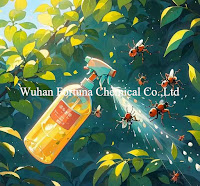Introduction
Ethyl butylacetylaminopropionate, CAS 52304-36-6, commonly known by its trade name IR3535 / BAAPE, is a synthetic insect repellent that has gained significant attention in recent years. Developed by Merck KGaA in the 1970s, this compound has been widely used in Europe and is gaining popularity in other parts of the world.
Introduction
Ethyl butylacetylaminopropionate, CAS 52304-36-6, commonly known by its trade name IR3535 / BAAPE, is a synthetic insect repellent that has gained significant attention in recent years. Developed by Merck KGaA in the 1970s, this compound has been widely used in Europe and is gaining popularity in other parts of the world.
Properties
Ethyl butylacetylaminopropionate is a colorless to pale yellow liquid with a mild odor. It is soluble in water and various organic solvents, making it versatile for formulation in different types of insect repellent products. The chemical structure of Ethyl butylacetylaminopropionate is characterized by an ester functional group, which contributes to its stability and efficacy. Its molecular formula is C13H25NO3, and it has a molecular weight of 243.34 g/mol. The compound is known for its low volatility, which enhances its longevity on the skin.
Uses
Ethyl butylacetylaminopropionate is primarily used as an insect repellent. It is effective against a wide range of insects, including mosquitoes, ticks, flies, and fleas. This makes it suitable for use in various applications, such as lotions, sprays, and wipes. It is also used in combination with other active ingredients to enhance its repellent properties. Additionally, it is incorporated into products like sunscreens and moisturizers, providing dual benefits of skin protection and insect repellency.
Mechanism of Action
The exact mechanism by which Ethyl butylacetylaminopropionate repels insects is not fully understood. However, it is believed to interfere with the olfactory receptors of insects, making it difficult for them to locate their human or animal hosts. This disruption in the insect’s ability to detect carbon dioxide and other attractants effectively reduces the likelihood of bites. Studies suggest that the compound may also affect the sensory neurons of insects, further deterring them from landing on treated surfaces.
Comparison with DEET
DEET (N,N-Diethyl-meta-toluamide) is one of the most well-known and widely used insect repellents. While both DEET and Ethyl butylacetylaminopropionate are effective, there are several key differences between the two:
Safety Profile: Ethyl butylacetylaminopropionate is considered to have a better safety profile compared to DEET. It is less likely to cause skin irritation and is generally regarded as safe for use on children and pregnant women. DEET, on the other hand, has been associated with skin irritation and, in rare cases, neurological effects.
Efficacy: Both compounds are effective against a broad spectrum of insects. However, DEET is often considered the gold standard for long-lasting protection. Ethyl butylacetylaminopropionate provides comparable efficacy but may require more frequent application.
DEET
Environmental Impact: Ethyl butylacetylaminopropionate is biodegradable and poses less risk to the environment compared to DEET, which can persist in water and soil.
Odor and Texture: Ethyl butylacetylaminopropionate has a milder odor and a less greasy texture compared to DEET, making it more pleasant to use.
Applications
Ethyl butylacetylaminopropionate is used in a variety of applications, catering to different consumer needs and preferences:
Personal Care Products: It is commonly found in lotions, creams, and sprays designed for personal use. These products are often marketed for their dual benefits, such as moisturizing the skin while providing insect protection.
Outdoor Gear: The compound is also used in outdoor gear like insect-repellent clothing, tents, and sleeping bags. These products are particularly popular among campers, hikers, and outdoor enthusiasts who require long-lasting protection.
Public Health Programs: Ethyl butylacetylaminopropionate is increasingly being used in public health initiatives to combat vector-borne diseases like malaria, dengue, and Zika virus. Its safety profile makes it suitable for widespread use in community settings.
Pet Care: The compound is also formulated into products designed for pets, such as flea and tick collars, sprays, and shampoos. This helps protect pets from insect-borne diseases and discomfort.
Household Products: It is incorporated into household insect repellents, including sprays and plug-in devices, to keep homes free from pests.
Advantages of Ethyl Butylacetylaminopropionate
Ethyl butylacetylaminopropionate offers several advantages that make it a preferred choice for many consumers:
Safety: Its excellent safety profile makes it suitable for use on sensitive skin, children, and pregnant women. This broadens its applicability and consumer base.
Environmental Friendliness: Being biodegradable, it poses less risk to the environment, making it a more sustainable choice.
User Experience: The mild odor and non-greasy texture enhance user comfort, encouraging regular use and thereby improving protection against insect bites.
Versatility: Its solubility in water and various organic solvents allows for diverse formulations, from sprays to lotions, catering to different consumer preferences.
Regulatory Approval: Ethyl butylacetylaminopropionate has been approved by various regulatory bodies, including the Environmental Protection Agency (EPA) in the United States and the European Chemicals Agency (ECHA). This adds an extra layer of assurance regarding its safety and efficacy.
Conclusion
Ethyl butylacetylaminopropionate is a highly effective and safe insect repellent that offers several advantages over traditional repellents like DEET. Its excellent safety profile, environmental friendliness, and user comfort make it an attractive option for consumers seeking reliable protection against insect bites. Its versatility in application and regulatory approval further enhance its appeal. As awareness of its benefits continues to grow, Ethyl butylacetylaminopropionate is likely to become a staple in insect repellent products worldwide.
Wuhan Fortuna Chemical Co.,Ltd is a professional manufacturer which provide Ethyl butylacetylaminopropionate with good quality and best price, welcome to contact us to get COA/TDS/MSDS of Ethyl butylacetylaminopropionate.
To know more information, please follow: https://www.fortunachem.com/
Email Us: sales@fortunachem.com
Call Us: +86-27-59207850















No comments:
Post a Comment